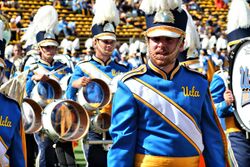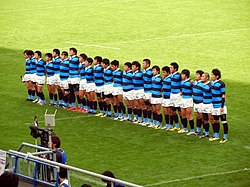School colors
Topic: Social
 From HandWiki - Reading time: 5 min
From HandWiki - Reading time: 5 min
School colors (also known as university colors or college colors) are the colors chosen by a school as part of its brand identity, used on building signage, web pages, branded apparel, and the uniforms of sports teams. They can promote connection to the school – or 'school spirit' – and help differentiate it from other institutions.[1]
Background
The tradition of school colors appears to have started in England in the 1830s. The University of Cambridge chose Cambridge blue for the Boat Race against the University of Oxford in 1836,[2] Westminster School have used pink as their color since a boat race against Eton School in 1837,[3] and Durham University adopted palatinate purple for its MA hood some time before that degree was first awarded in 1838.[4]
Many US colleges adopted school colors between 1890 and 1910. These were generally chosen to be distinctive, something that grew harder as more colors and color combinations were taken, although many Presbyterian colleges chose to imitate Princeton University's black and orange.[5] Some American schools, in a display of patriotism, adopted the national colors of "red, white, or blue."[6]
The most popular colors among US colleges ranked in the 2012 Forbes Top 50 or in the 2012–13 NCAA basketball or cross-country rankings were white, blue, red, black, and gold. These same five colors were the most popular five colors among colleges in each of the three rankings individually.[7]
Sports
The use of colors to identify university sports teams dates back at least to the second Boat Race between Oxford and Cambridge in 1836.[2] While most universities use the same color(s) for their sports and other university branding, Cambridge Blue is only one of twelve colors in the supporting palette for the university, not one of their six core colors.[8] The University of Nottingham uses green and gold for its sports, but the rest of the university uses blue as its brand color.[9][10] Roger Williams University changed its athletics colors in 2018 to match the university colors, in order to "foster a strong, unified visual identity for RWU Athletics that is more cohesive with the overall University", stating that "this combination will be powerful in strengthening RWU's brand identity and awareness".[11]
Most competitive teams keep two sets of uniforms, with one emphasizing the primary color and the other emphasizing the secondary color. In some sports, such as American football, the primary color is emphasized on home uniforms, while uniforms for other sports, notably basketball, use the secondary or a neutral color at home, most commonly white. This is done to avoid confusing the two schools' colors.[citation needed]
In addition, various groups that generate support for athletic teams, including cheerleaders and marching bands, wear uniforms with the colors of their school. At many private schools, or more traditional state schools, "school colors" are awards presented for achievement in a subject or a sport.[citation needed]
Nicknames
The university color can sometimes become a nickname for the sports program. For example, the Palatinate (Durham) and the African Violet (Loughborough) in the UK,[12][13] and the Harvard Crimson and Cornell Big Red in the US.[14]
Academic dress

School colors are also used in the academic dress of many institutions. The first school color adopted by a university for its academic dress was palatinate purple at Durham University, England, some time between 1835 and 1838.[15][4] Schools in the US that award an academic hood to their students and abide by the American Council on Education guidelines use hoods lined with their school colors and trimmed with velvet in a color indicating the discipline of the degree.[16] Some US doctoral robes will also be in the colors of the university which granted the degree, departing from the Academic Costume Code color of black.[17]
Academic scarves
Many British, Irish and Commonwealth universities and some American universities have an academic scarf in the university's colors, usually long, woollen and patterned only with lengthwise stripes of varying widths. At collegiate universities such as Oxford, Cambridge, Durham and Lancaster, each college has its own colors and scarf. Other non-collegiate universities such as Glasgow and Newcastle have scarf colors for each faculty.[18]
Notable school colors

- Cambridge blue – University of Cambridge
- Carolina blue – University of North Carolina
- Columbia blue – Columbia University
- Duke blue – Duke University
- Eton blue – Eton School
- Oxford blue – University of Oxford
- Palatinate – Durham University
- Yale blue – Yale University
See also
- Gang colors
- Colors (motorcycling)
- Sports uniform
- Varsity letter
- Couleur
References
- ↑ Hilda R. Glazer; Constance E. Wanstreet (31 August 2011). "Building a Brand in Virtual Learning Spaces: Why Student Connections Matter". in Victor C. X. Wang. Encyclopedia of E-Leadership, Counseling and Training. ICI Global. pp. 835–836. ISBN 9781613500699. https://books.google.com/books?id=VCFcfdQQFkwC&pg=PA835.
- ↑ 2.0 2.1 "Oxbridge Blue. How to win the varsity match.". The Field. 2015-04-07. https://www.thefield.co.uk/country-house/oxbridge-blue-21962.
- ↑ John Sargeaunt (1898). Annals of Westminster School. Methuen & Company. p. 238. https://books.google.com/books?id=lnwWAAAAIAAJ&pg=PA238.
- ↑ 4.0 4.1 C. E. Whiting (1932). The University of Durham 1832-1932'. Sheldon Press. p. 141.
- ↑ John R. Thelin (2019). A History of American Higher Education. Johns Hopkins University Press. pp. 158–159. https://books.google.com/books?id=NeuADwAAQBAJ&pg=PA159.
- ↑ "History of Penn Colors, University of Pennsylvania University Archives". http://www.archives.upenn.edu/histy/genlhistory/colors.html.
- ↑ Haley Omasta; Stacey Hills (2015). "Official College and University Colors: Student Perception vs. Performance". Proceedings of the National Conference on Undergraduate Research (NCUR). http://libjournals.unca.edu/ncur/wp-content/uploads/2021/07/1399-Omasta-Haley-FINAL.pdf.
- ↑ "Colour palette". University of Cambridge. https://www.cam.ac.uk/brand-resources/guidelines/typography-and-colour/colour-palette.
- ↑ "University of Nottingham Sport Brand". University of Nottingham. https://www.nottingham.ac.uk/sport/brand/index.aspx.
- ↑ "Colour". University of Nottingham. https://www.nottingham.ac.uk/brand/visual/colour.aspx.
- ↑ Edward Fitzpatrick (25 July 2019). "RWU Releases New Hawks Logo". UWIRE Text. Gale Academic OneFile. https://link.gale.com/apps/doc/A548727134/AONE?u=nm_p_oweb&sid=googleScholar&xid=982c882f.
- ↑ Ben King (27 September 2023). "University Rugby: League champions Loughborough off the mark with battling win over Nottingham". Talking Rugby Union. https://www.talkingrugbyunion.co.uk/bucs-round-up/37154.htm.
- ↑ "Women’s National League 2023-24 - Fixtures Released!". 21 July 2023. https://www.bucs.org.uk/resources-page/women-s-national-league-2023-24-fixtures-released.html.
- ↑ Dennis J. Zheng (4 February 2010). "Big Red Contains Crimson". The Harvard Crimson. https://www.thecrimson.com/article/2010/2/4/mbasketball-column-020410/.
- ↑ Groves, Nicholas (2003). "Did you know that ...?". Transactions of the Burgon Society (Burgon Society) 3: 63. doi:10.4148/2475-7799.1022.
- ↑ "Academic Regalia". American Council on Education. https://www.acenet.edu/Programs-Services/Pages/Academic-Regalia.aspx. Retrieved 8 December 2022.
- ↑ Boven, David T. (2009). "American Universities' Departure from the Academic Costume Code". Transactions of the Burgon Society 9. doi:10.4148/2475-7799.1075.
- ↑ "A brief history of academic scarves". Study.EU. http://www.study.eu/article/a-brief-history-of-academic-scarves.
External links
 |
 KSF
KSF


